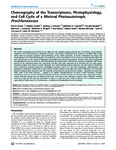Choreography of the Transcriptome, Photophysiology, and Cell Cycle of a Minimal Photoautotroph, Prochlorococcus
| dc.contributor.author | Zinser, ER | |
| dc.contributor.author | Lindell, D | |
| dc.contributor.author | Johnson, ZI | |
| dc.contributor.author | Futschik, ME | |
| dc.contributor.author | Steglich, C | |
| dc.contributor.author | Coleman, ML | |
| dc.contributor.author | Wright, MA | |
| dc.contributor.author | Rector, T | |
| dc.contributor.author | Steen, R | |
| dc.contributor.author | McNulty, N | |
| dc.contributor.author | Thompson, LR | |
| dc.contributor.author | Chisholm, SW | |
| dc.date.accessioned | 2017-02-07T19:49:40Z | |
| dc.date.available | 2017-02-07T19:49:40Z | |
| dc.date.issued | 2009 | |
| dc.identifier.issn | 1932-6203 | |
| dc.identifier.issn | 1932-6203 | |
| dc.identifier.other | ARTN e5135 | |
| dc.identifier.uri | http://hdl.handle.net/10026.1/8407 | |
| dc.description.abstract |
The marine cyanobacterium Prochlorococcus MED4 has the smallest genome and cell size of all known photosynthetic organisms. Like all phototrophs at temperate latitudes, it experiences predictable daily variation in available light energy which leads to temporal regulation and partitioning of key cellular processes. To better understand the tempo and choreography of this minimal phototroph, we studied the entire transcriptome of the cell over a simulated daily light-dark cycle, and placed it in the context of diagnostic physiological and cell cycle parameters. All cells in the culture progressed through their cell cycles in synchrony, thus ensuring that our measurements reflected the behavior of individual cells. Ninety percent of the annotated genes were expressed, and 80% had cyclic expression over the diel cycle. For most genes, expression peaked near sunrise or sunset, although more subtle phasing of gene expression was also evident. Periodicities of the transcripts of genes involved in physiological processes such as in cell cycle progression, photosynthesis, and phosphorus metabolism tracked the timing of these activities relative to the light-dark cycle. Furthermore, the transitions between photosynthesis during the day and catabolic consumption of energy reserves at night- metabolic processes that share some of the same enzymes--appear to be tightly choreographed at the level of RNA expression. In-depth investigation of these patterns identified potential regulatory proteins involved in balancing these opposing pathways. Finally, while this analysis has not helped resolve how a cell with so little regulatory capacity, and a 'deficient' circadian mechanism, aligns its cell cycle and metabolism so tightly to a light-dark cycle, it does provide us with a valuable framework upon which to build when the Prochlorococcus proteome and metabolome become available. | |
| dc.format.extent | e5135-e5135 | |
| dc.format.medium | Print-Electronic | |
| dc.language | en | |
| dc.language.iso | eng | |
| dc.publisher | Public Library of Science (PLoS) | |
| dc.subject | Bacterial Proteins | |
| dc.subject | Cell Cycle | |
| dc.subject | Darkness | |
| dc.subject | Genes, Bacterial | |
| dc.subject | Light | |
| dc.subject | Photosynthesis | |
| dc.subject | Prochlorococcus | |
| dc.subject | RNA, Messenger | |
| dc.title | Choreography of the Transcriptome, Photophysiology, and Cell Cycle of a Minimal Photoautotroph, Prochlorococcus | |
| dc.type | journal-article | |
| dc.type | Article | |
| plymouth.author-url | https://www.ncbi.nlm.nih.gov/pubmed/19352512 | |
| plymouth.issue | 4 | |
| plymouth.volume | 4 | |
| plymouth.publication-status | Published online | |
| plymouth.journal | PLoS ONE | |
| dc.identifier.doi | 10.1371/journal.pone.0005135 | |
| plymouth.organisational-group | /Plymouth | |
| plymouth.organisational-group | /Plymouth/Faculty of Health | |
| plymouth.organisational-group | /Plymouth/Users by role | |
| dc.publisher.place | United States | |
| dcterms.dateAccepted | 2009-01-19 | |
| dc.identifier.eissn | 1932-6203 | |
| dc.rights.embargoperiod | Not known | |
| rioxxterms.versionofrecord | 10.1371/journal.pone.0005135 | |
| rioxxterms.licenseref.uri | http://www.rioxx.net/licenses/all-rights-reserved | |
| rioxxterms.licenseref.startdate | 2009 | |
| rioxxterms.type | Journal Article/Review |


